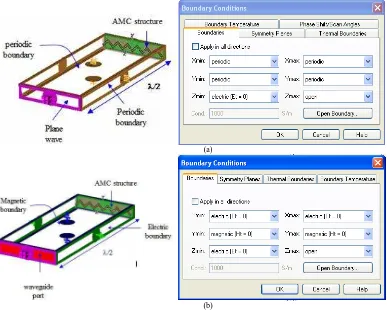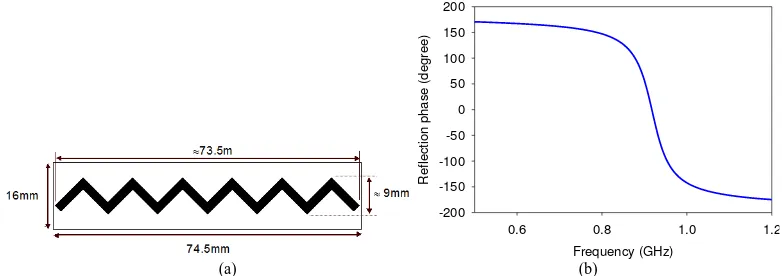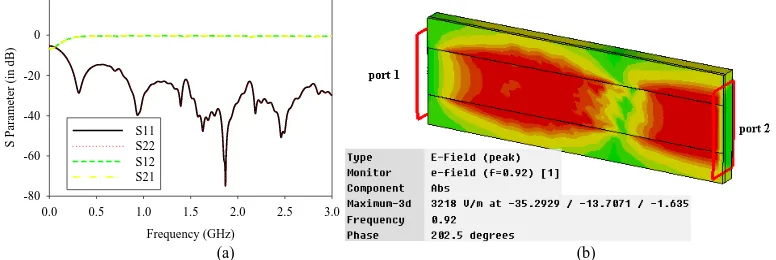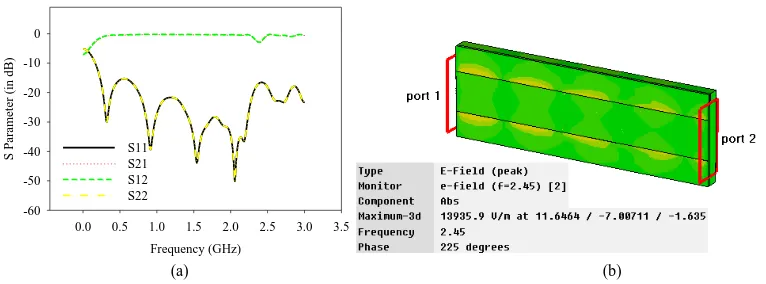58 (2012) 19–25 | www.jurnalteknologi.utm.my | eISSN 2180–3722 | ISSN 0127–9696
Teknologi
Single-band Zigzag Dipole Artificial Magnetic Conductor
M. Abua*, M. K. A. Rahima
a
Universiti Teknikal Malaysia Melaka (UTeM), Hang Tuah Jaya, 76109 Durian Tunggal, Melaka b
Faculty of Electrical Engineering, Universiti Teknologi Malaysia, 81310 UTM Johor Bahru
*Corresponding author: maisarah@utem.edu.my
Article history
Received: 8 March 2012
Received in revised form: 10 April 2012
Accepted: 18 July 2012
Graphical abstract
Abstract
A new Artificial Magnetic Conductor (AMC) structure called zigzag dipole is discussed. Based on the 0.92GHz straight dipole AMC, the zigzag dipole AMC operating at 0.92GHz, 2.45GHz and 5.8GHz are carried out using TLC-32 and RF-35 boards. This AMC structure is designed based on the characterization of a unit cell using a transient solver of Computer Simulation Technology (CST) software. The simulated results such as the reflection phase, reflection magnitude, surface impedance, bandgap and electric field for each single-band AMC are presented in this paper. From the results gained it shows that, the bandwidth of the AMC will increase when the frequency is increased. It is also proved that these AMC are not providing the bandgap at their resonance. The zigzag dipole AMC is carried out to minimize the AMC size and to be suitable for UHF RFID applications.
Keywords: High Impedance Surface (HIS); Artificial Magnetic Conductor (AMC); zigzag dipole AMC
© 2012 Penerbit UTM Press. All rights reserved.
1.0 INTRODUCTION
Generally, AMC is realized within a limited frequency range. The AMC is characterized when its reflection phase and magnitude is 0 and +1 at resonance. It has in-phase reflected waves with the incident waves oppose to the perfect electric conductor (PEC). The PEC has a reflectivity of -1 and has electromagnetic waves out of phase with the incident waves. It is a high impedance surface (HIS) structure which has zero tangential magnetic fields, a lossless and can approximate as an open circuit due to the very high surface impedance it has at resonance. The AMC also known as Perfect Magnetic Conductor (PMC) and it is categorized as metamaterial structure that exhibit novel electromagnetic properties not exist in nature [1-4].
It is called as “artificial” magnetic conductor because it is
“artificial engineered material” with a magnetic conductor
surface at certain frequency range. In other words, the AMC is a subclass of metamaterials or a type of electromagnetic bandgap (EBG) [5-6]. Furthermore, the AMC is understood as a prominent candidate for a ground plane of low-profile antennas. This is because, to ensure that the dipole antenna to work properly at its resonant frequency, the antenna must be placed at a quarter-wavelength above the metallic ground plane, making the antenna bulky at low frequencies. So, a thin, low profile antenna using a high impedance ground plane (GP) was presented in [7-9]. As the metallic plate, the AMC also can be
used as a ground plane to redirect the back radiation and provide shielding to the antennas.
Generally, a meandered or folded dipole film tag antenna has been popular for Radio Frequency Identification (RFID) tag antenna structure. When the antenna is attached to a metallic object, the dipole tag antenna cannot be powered up by the field strength emitted by the reader since the metallic object reflects RF wave. The impedance of the tag antenna, resonant frequency of the antenna and radiation efficiency will be changed due to the parasitic capacitance between the tag antenna and the metallic object [10, 11]. To minimize effects of the parasitic capacitor between the dipole antenna and metallic object and the effect of the reflection of the RF wave by metallic object, a gap between tag antenna and the metallic object is placed and dielectric material between them is added [12]. But in [13], they stated that the tag performance mainly due to various kinds of platform materials can be prevented and the antenna gain also can be increased when AMC is used as a ground plane to the low-profile antenna. The AMC structure was studied in [14] to make a low-profile passive RFID tag whose performance is tolerant to metallic objects.
2.0SIMULATION SET-UP
simulating a lattice or a unit cell of the AMC structure with periodic boundary conditions at the side walls as depicted in Figure 1(a). A probe to record the signals in magnitude and phase at a distance of half-wavelength is positioned in front of the AMC structure. The reflected signal is then accumulated and computed by a separate program applied in the Visual Basic for Applications (VBA) macro where the actual AMC structure,
PEC structure and vacuum structure are simulated accordingly. The detail simulation set-up for designing HIS can be found in [15, 16]. The reflection magnitude and the surface impedance of the designed AMC are then obtained by simulating a unit cell with electric and magnetic boundary condition at the vertical and horizontal walls as depicted in Figure 1(b).
(a)
(b)
Figure 1 The simulation set-up to obtain the: (a) reflection phase diagram and (b) reflection magnitude and surface impedance of the AMC structure
3.0INITIAL DESIGN
Based on [17], a design of straight dipole AMC operating at 0.92GHz is presented here as an initial design for zigzag dipole AMC. As shown in Figure 2 (a), the unit cell of the straight dipole AMC has a dimension of 90.5mm x 16mm. The conductor line with width of 2mm is printed on the dielectric substrate having a permittivity of 3.2 and thickness of 6.35mm. It is backed by a metal plane of 0.035mm thickness. The length l of the conductor on top of the substrate is given approximately as:
r
l
2
0
or g/2 (1)where 0 and g is the free-space and guided wavelength at
0.92GHz.
The simulated reflection phase of the straight dipole AMC is plotted in Figure 2(b). The reflection phase of the AMC structure varies from -180 to +180 related to the frequency
and 0 degree at the resonant frequency. Referring to Figures 3(a) and 3(b), the designed AMC has a reflection coefficient of 0.93 which corresponds to -0.61dB and has very high impedance at 0.92GHz.
4.0 ZIGZAG DIPOLE AMC DESIGNIn this section, the design of single-band zigzag dipole AMCs are presented. The simulated results such as the reflection phase, reflection magnitude, surface impedance, bandgap and electric field for each AMC are investigated.
4.1 0.92GHz Zigzag Dipole AMC-HIS
reduction four times smaller than the square-patch AMC presented in [18].
Figure 2 A straight dipole AMC-HIS design at 0.92GHz: (a) unit cell and (b) reflection phase
Frequency (GHz)
Figure 3 0.92GHz straight dipole AMC-HIS: (a) reflection magnitude and (b) surface impedance
Frequency (GHz)
Figure 4 The zigzag dipole AMC-HIS design at 0.92GHz: (a) unit cell and (b) reflection phase
From the phase reflection diagram plotted in Figure 4(b), the computed AMC bandwidth of the zigzag dipole is 7.65%. The expression of the AMC bandwidth is stated in equation (2) where fu is the upper frequency when the reflection phase equals
-90, fL is the lower frequency when the reflection phase equals
+90 and fr is the resonant frequency when the reflection phase
equals 0. At this AMC region, no destructive interference occurs.
(2)
structure has a reflection coefficient of 0.93 or -0.61dB with very high impedance around the operating frequency.
Frequency (GHz)
0.0 0.5 1.0 1.5 2.0 2.5
Refle
cti
on magnitude
0.92 0.94 0.96 0.98 1.00
Frequency (GHz)
0.80 0.85 0.90 0.95 1.00
Surfa
ce
i
mpe
da
nc
e (
Ohm)
-20x103
-10x103
0 10x103
20x103
Real Imaginary
(a) (b)
Figure 5 0.92GHz zigzag dipole AMC-HIS: (a) reflection magnitude and (b) surface impedance
As shown in Figure 6, a transmission line method is used to study the bandgap of the zigzag dipole AMC structure. Figure 7(a) shows the S parameter graph for the grounded zigzag dipole Frequency Selective Surface (FSS). It shows that, there
are no bandgap appear at the specific frequency range. The electric field at the resonant frequency of 0.92GHz is illustrated in Figure 7(b). As can be seen in this figure, it illustrates that the current is flowing from port 1 to the port 2.
Figure 6 A transmission line method is used to study the bandgap of the AMC-HIS
Frequency (GHz)
0.0 0.5 1.0 1.5 2.0 2.5 3.0
S Pa
ra
met
er
(in
d
B)
-80 -60 -40 -20 0
S11 S22 S12 S21
(a) (b)
Figure 7 0.92GHz zigzag dipole AMC: (a) bandgap and (b) electric field
4.2 2.45GHz Zigzag Dipole AMC-HIS
A 2.45GHz zigzag dipole AMC-HIS is designed on the same Taconic substrate used for 0.92GHz zigzag dipole AMC-HIS. The substrate size of the unit cell of this AMC is 29.5mm x 7.5mm. The zigzag dipole configuration has a length of 24.7mm and width of 4.5mm. From the simulated results, the obtained
Frequencies (GHz)
Figure 8 The zigzag dipole AMC-HIS design at 2.45GHz: (a) unit cell and (b) reflection phase
Referring to Figure 9(a), the simulated reflection magnitude of structure and the gap between the unit cells is large (more than 3mm).
Figure 9 2.45GHz zigzag dipole AMC-HIS: (a) reflection magnitude and (b) surface impedance
Frequency (GHz)
Figure 10 2.45GHz zigzag dipole AMC: (a) bandgap and (b) electric field
4.3 5.8GHz Zigzag Dipole AMC-HIS
In this case, a 5.8GHz zigzag dipole AMC-HIS is designed using the different Taconic substrate; RF-35 which has a permittivity and thickness of 3.54 and 1.524mm respectively.
Frequencies (GHz)
Figure 11 The zigzag dipole AMC-HIS design at 5.8GHz: (a) unit cell and (b) reflection phase
By simulating a unit cell of the AMC with the electric and magnetic boundary condition at the vertical and horizontal walls, the reflection magnitude and surface impedance of the structure are carried out. A 0.97 or -0.29dB reflection magnitude is recorded at 5.8GHz. From the surface impedance graph
plotted in Figure 12(b), the impedance magnitude of 7057 is obtained. Hence, from these studied, it proved that the reflection coefficient magnitude and impedance of the structure ideally can achieves +1 and infinity.
Frequencies (GHz)
Figure 12 5.8GHz zigzag dipole AMC-HIS: (a) reflection magnitude and (b) surface impedance
From the transmission line method used to measure the bandgap of the designed AMC, the obtained S parameters are plotted in Figure 13(a). Due to the same reason as before, it is
clearly shows that there are no bandgap appeared at the operating frequency and so that the current is allowed to flow from one port to another port.
Frequency (GHz)
Figure 13 5.8GHz zigzag dipole AMC: (a) bandgap and (b) electric field
5.0CONCLUSION AN FUTURE WORKS
New structure for the single-band AMC operating at 0.92GHz, 2.45GHz and 5.8GHz are proposed based on the straight dipole AMC called zigzag dipole AMC. The 0.92GHz and 2.45GHz
applied in the structure. The presented AMCs are simple and much less complex because no vias are applied, easy to fabricate and low fabrication cost. The designed AMCs are then will be used as a ground plane for the printed dipole antenna, and their performance will be investigated. The unique property of the AMC which has in-phase reflection with incident waves will enhance the radiation properties of the dipole antenna mounted on a metallic surface
Acknowledgements
The authors thank the Ministry of Higher Education (MOHE), Research Management Centre (RMC) and Radio Communication Engineering Department (RACeD), Universiti Teknologi Malaysia (UTM) for supporting the research work.
References
[1] Sievenpiper, D. F. 1999. High-Impedance Electromagnetic Surfaces. PhD Thesis. University of California at Los Angeles.
[2] Ying-Ying Gu, Wen-Xun Zhang, Zhi-Chen Ge and Zhen-Guo Liu. 2005. Research on Reflection Phase Characterizations of Artificial Magnetic Conductors. 2005 Antennas and Propagation and Microwave Conference, APMC2005.
[3] J. R. Sohn, K. Y. Kim and H.-S. Tae. 2006. Comparative Study on Various Artificial Magnetic Conductors for Low-profile Antenna. Progress In Electromagnetics Research, PIER. 61: 27–37.
[4] Sim, Dong-uk, Choi, Hyung-do, Kwon, Jong-hwa, Kim, Dong-ho, Choi, Jae-ick. 2010. Dipole Tag Antenna Structure Mountable on Metallic Objects using Artificial Magnetic Conductor for Wireless Identification and Wireless Identification System using the Dipole Tag Antenna Structure. United States Patent, 20100007569.
[5] Douglas J. Kern, Douglas H. Werner, Agostino Monorchio, Luigi Lanuzza and Michael J. Wilhelm. 2005. The Design Synthesis of Multiband Artificial Magnetic Conductors using High Impedance Frequency Selective Surfaces. IEEE Transactions on Antennas and Propagation. 53(1): 8–17.
[6] Douglas, J. K., D. H. Werner, M. J. Wilhelm and K. H. Church. 2003. Genetically Engineered Multiband High-impedance Frequency Selective Surfaces. Microwave and Optical Technology Letters. 38(5): 400–403.
[7] Ying Huang, Arijit De, Yu Zhang, Tapan K. Sarkar and Jeffrey Carlo. 2008. Enhancement of Radiation along the Ground Plane from a Horizontal Dipole Located Close to It. IEEE Antennas and Wireless Propagation Letters. 294–297.
[8] Fan Yang and Rahmat Samii. 2009. Electromagnetic Band Gap Structures in Antenna Engineering. Cambridge University Press. 156– 201.
[9] Gopinath Gampala, Rohit Sammeta and C. J. Reddy. 2010. A Thin, Low Profile Antenna using a Novel High Impedance Ground Plane. Microwave Journal. 53(7).
[10] Harvey Lehpamer. 2008. RFID Design Principles. Artech House. [11] Zhi Ning Chen. 2007. Antenna for Portable Devices. John Wiley &
Sons. 71–72.
[12] Youngman Um, Uisheon Kim, Wonmo Seong and Jaehoon Choi. 2007. A Novel Antenna Design for UHF RFID Tag on Metallic Objects. PIERS Proceedings, August 27-30, Prague, Czech Republic. [13] R. M. Mateos, J. M. Gonzalez, C. Craeye and J. Romeu. 2007.
Backscattering measurement from a RFID tag based on artificial magnetic conductors. 2nd European Conference on Antennas and Propagation (EuCAP 2007). Edinburgh, UK, 11-16 Nov.
[14] Dongho Kim and Junho Yeo, 2008. Low-profile RFID tag antenna using compact AMC substrate for metallic objects. IEEE Antennas and Wireless Propagation Letters. 7: 718–720.
[15] M. E. de Cos, F. Las Heras and M. Franco. 2009. Design of Planar Artificial Magnetic Conductor Ground Plane using Frequency Selective Surface for Frequencies Below 1GHz. IEEE Antennas and Wireless Propagation Letters. 8: 951–954.
[16] M. E. de Cos, Y. Alvarez Lopez, R. C. Hadarig and F. Las-Heras Andrés. 2010. Flexible Uniplanar Artificial Magnetic Conductor. Progress In Electromagnetics Research, PIER 106. 349–362. [17] Hiranandani, M. A. Yakovlev, A. B. Kishk, A. A. 2006. Artificial
Magnetic Conductors Realised by Frequency-Selective Surfaces on a Grounded Dielectric Slab for Antenna Applications. IEE Proceedings on Microwaves, Antennas and Propagation. 153(5): 487–493. [18] M. Abu, M. K. A. Rahim, O. Ayop and F. Zubir. 2010. Triple-Band




